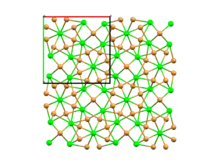Samarium(II) bromide
Samarium(II) bromide is an inorganic compound with the chemical formula SmBr
2.[6] It is a brown solid that is insoluble in most solvents but degrades readily in air.[2]
 | |
| Names | |
|---|---|
| IUPAC name
samarium(II) bromide | |
| Other names
samarium dibromide dibromosamarium | |
| Identifiers | |
3D model (JSmol) |
|
| ChemSpider | |
PubChem CID |
|
| |
| |
| Properties | |
| SmBr2 | |
| Molar mass | 310.17 g/mol[1] |
| Appearance | Brown crystals |
| Melting point | 669 °C (1,236 °F; 942 K)[2] |
| Boiling point | 1,880 °C (3,420 °F; 2,150 K) |
| +5337.0·10−6 cm3/mol [3][4] | |
| Structure | |
| SrBr2[5] | |
| Hazards | |
| GHS labelling: | |
 | |
| Warning[1] | |
| H315, H319, H335[1] | |
| P261, P305+P351+P338[1] | |
| Related compounds | |
Other anions |
Samarium(II) chloride Samarium(II) iodide |
Other cations |
Samarium(III) bromide |
Except where otherwise noted, data are given for materials in their standard state (at 25 °C [77 °F], 100 kPa).
Infobox references | |
Structure
In the gas phase, SmBr
2 is a bent molecule with Sm–Br distance 274.5 pm and bond angle 131±6°.[7]
History
Samarium(II) bromide was first synthesized in 1934 by P. W. Selwood, when he reduced samarium tribromide (SmBr3) with hydrogen (H2). Kagan also synthesized it by converting samarium(III) oxide (Sm2O3) to SmBr3 and then reducing with a lithium dispersion in THF. Robert A. Flowers synthesized it by adding two equivalent of lithium bromide (LiBr) to samarium diiodide (SmI2) in tetrahydrofuran. Namy managed to synthesize it by mixing tetrabromoethane (C2H2Br4) with samarium metal, and Hilmerson found that heating the tetrabromoethane or samarium greatly improved the production of samarium(II) bromide.[8]
Reactions
Samarium(II) bromide has reducing properties reminiscent of the more commonly used samarium diiodide.[9] It is an effective for pinacol homocouplings of aldehydes, ketones, and cross-coupling carbonyl compounds. Reports have shown that samarium(II) bromide is capable of selectively reducing ketones if it is in the presence of an alkyl halide.[8]
Samarium(II) bromide forms soluble adducts with hexamethylphosphoramide. This species reduces imines to amines and alkyl chlorides to hydrocarbons.[10] For example, SmBr2(hmpa)x converts cyclohexyl chloride to cyclohexane.[11]
Samarium(II) bromide will reduce ketones in tetrahydrofuran if an activator is absent.[12]
References
- "Samarium(II) bromide 99.95% | Sigma-Aldrich". www.sigmaaldrich.com. Retrieved 20 December 2016.
- Haynes, William M. (2013). CRC handbook of chemistry and physics : a ready-reference book of chemical and physical data (94th ed.). CRC Press. p. 86. ISBN 9781466571150.
- Haynes, William M. (2013). CRC handbook of chemistry and physics : a ready-reference book of chemical and physical data (94th ed.). CRC Press. p. 135. ISBN 9781466571150.
- Lide, David R. (2004). CRC handbook of chemistry and physics : a ready-reference book of chemical and physical data (85th ed.). Boca Raton [u.a.]: CRC Press. p. 147. ISBN 9780849304859.
- Sass, Ronald L.; Brackett, Thomas; Brackett, Elizabeth (December 1963). "The Crystal Structure of Strontium Bromide". The Journal of Physical Chemistry. 67 (12): 2862–2863. doi:10.1021/j100806a516.
- Elements, American. "Samarium Bromide SmBr2". American Elements. Retrieved 20 December 2016.
- Ezhov, Yu. S.; Sevast'yanov, V. G. (January 2004). "Molecular Structure of Samarium Dibromide". Journal of Structural Chemistry. 45 (1): 160–164. doi:10.1023/B:JORY.0000041516.14569.9c. S2CID 96049918.
- Skrydstrup, David J. Procter, Robert A. Flowers, Troels (2009). Organic synthesis using samarium diiodide a practical guide. Cambridge: Royal Society of Chemistry. p. 157. ISBN 9781847551108.
{{cite book}}: CS1 maint: multiple names: authors list (link) - Ho, Tse-Lok (2016). Fiesers' Reagents for Organic Synthesis Volume 28. John Wiley & Sons. p. 486. ISBN 9781118942819.
- Pecharsky, Vitalij K.; Bünzli, Jean-Claude G.; Gschneidner, Karl A. (2006). Handbook on the physics and chemistry of rare earths. Amsterdam: North Holland Pub. Co. p. 431. ISBN 9780080466729.
- Couty, Sylvain; Baird, Mark S.; Meijere, Armin de; Chessum, Nicola; Dzielendziak, Adam (2014). Science of Synthesis: Houben-Weyl Methods of Molecular Transformations Vol. 48: Alkanes. Georg Thieme Verlag. p. 153. ISBN 9783131722911.
- Brown, Richard; Cox, Liam; Eames, Jason; Fader, Lee (2014). Science of Synthesis: Houben-Weyl Methods of Molecular Transformations Vol. 36: Alcohols. Georg Thieme Verlag. p. 129. ISBN 9783131721310.